Subscribe to our newsletter
When economy meets environment: Sustainable development and the case of wastewater pollution in textile manufacturing
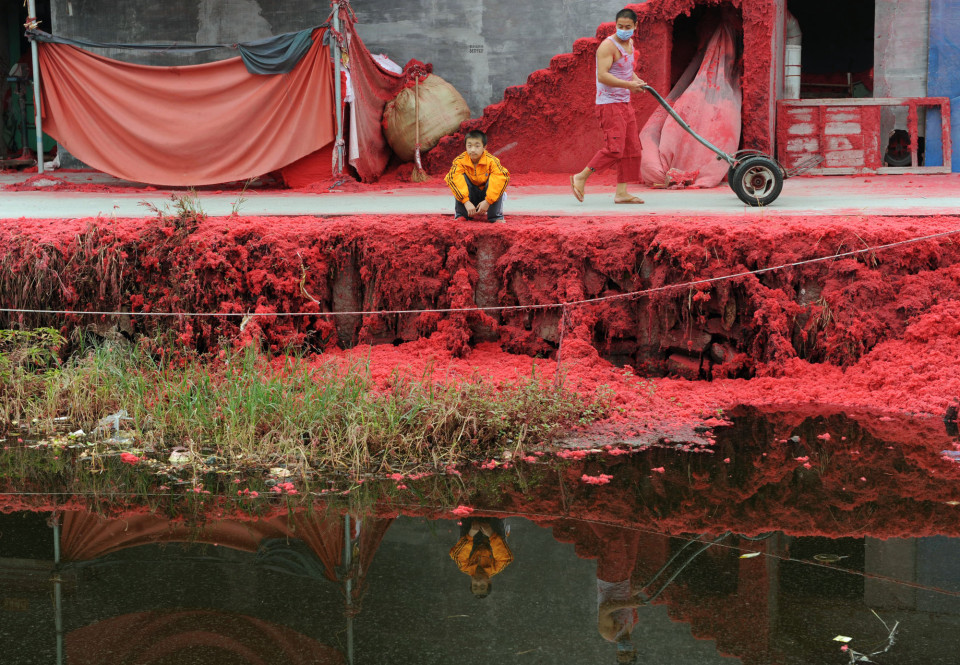
“Good water quality is essential to human health, social and economic development, and the ecosystem. However, as populations grow and natural environments become degraded, ensuring there are sufficient and safe water supplies for everyone is becoming increasingly challenging. A major part of the solution is to produce less pollution and improve the way we manage wastewater.” 1
The increase in water contamination and pollution due to human activity has resulted in one of today’s most critical environmental challenges, with worsening water pollution affecting both developed and developing countries. In the latter, it is mostly due to rapid population growth and urbanisation, increased industrial and other economic activities, as well as political and public apathy to improve and maintain water and wastewater management processes in the long-term.2
Untreated wastewater has a severely detrimental impact on the environment, and the rapid industrialisation that has been evident during the last few decades has significantly increased the amount of pollutants in the environment. Improper treatment of some hazardous industrial wastes released into bodies of water has had toxic effects on all types of life forms, both directly and indirectly.3 Textile dyeing is the second-largest polluter of water worldwide, with the fashion industry producing 20% of the world’s wastewater alone. This is because textile manufacturers use large amounts of water and the resulting wastewater produces highly polluted discharge.
Research has shown that the social and economic development in China has led to a significant deterioration in the water environment, which has limited sustainable regional development.4 The textile industry in China is one of the country’s most important industries. Its biggest impact on the environment is related to primary water consumption and wastewater discharge. The manufacturing of textiles has created serious challenges for water sustainability, characterised by intensive chemical consumption and waterborne pollution.5
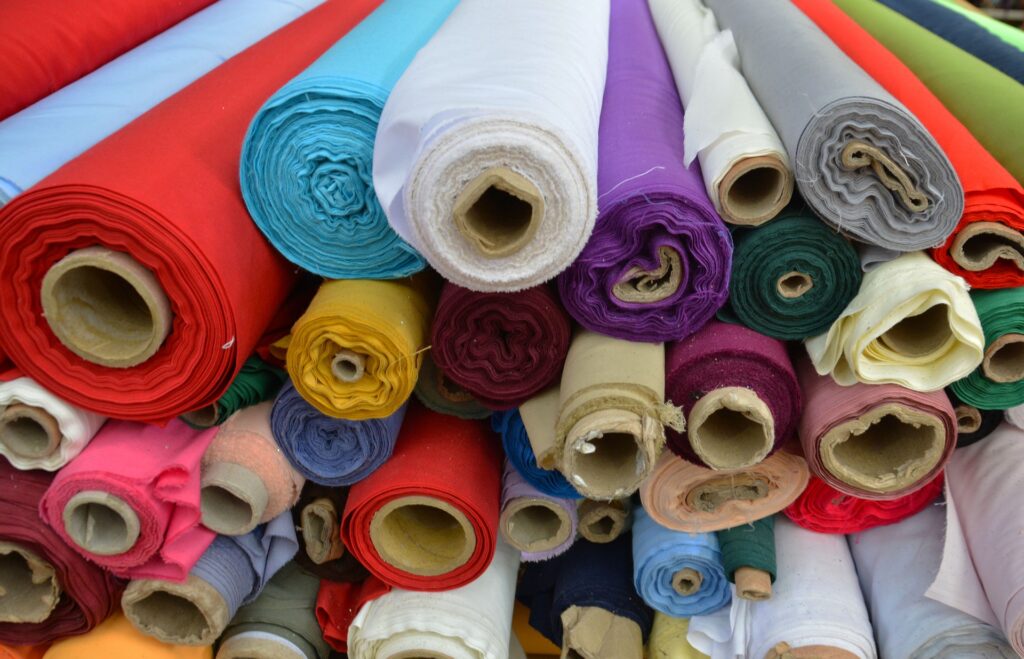
Understanding the factors that impact on the water environment is vital for future water conservation efforts. With the acceleration of industrialisation, China’s water quality has deteriorated to become one of the world’s worst,6 and it has the fourth largest freshwater reserves in the world alongside one fifth of the world’s population. Due to increasing demands over water use, such resources are being increasingly and extensively exploited for economic purposes.7 However, in recent years, the Chinese government has implemented more stringent environmental regulations in an attempt to change the situation.8
One reason for this turnaround could be related to the widespread adoption of the United Nations Sustainable Development Goals (SDGs), and in particular SDG6, which sets out to “ensure availability and sustainable management of water and sanitation for all”.9 The achievement of this Goal, even if partially, would greatly benefit people and the planet, given the importance of clean water for socio-economic development and quality of life, including health and environmental protection. SDG6 considers improvement of water quality by reducing by half the amount of wastewater that is not treated by 2030.
Digital Science’s goal is to try to change the scientific ecosystem by challenging the way things are done and act To interrogate the research being done on this important topic, we used Dimensions to identify research publications associated with wastewater and the textile manufacturing industry with the intention of seeing each country’s – in particular China’s – contribution to research in this space. An initial search looked at wastewater and water pollution to clarify the extent of research output in this area, and to identify the countries where there appeared to be a significant research focus.The extent of research being undertaken across these domains highlighted the countries with the greatest number of publications in wastewater pollution, and showed that China, the United States and India in particular, had the greatest research output.
Delving deeper into the data from DImensions, we developed a more specific search focusing on wastewater and water pollution while also introducing terms related to the textile industry, thus creating a narrower search focus.10 We also used keywords sourced following an extensive literature search – the full search string can be found at the end of this blog. Using the detailed search we investigated this area of research in the context of a number of domains including the UN SDGs, Fields of Research (FoRs), and also looked at the top research producing countries to explore research outputs in more detail (see Fig.2 below).
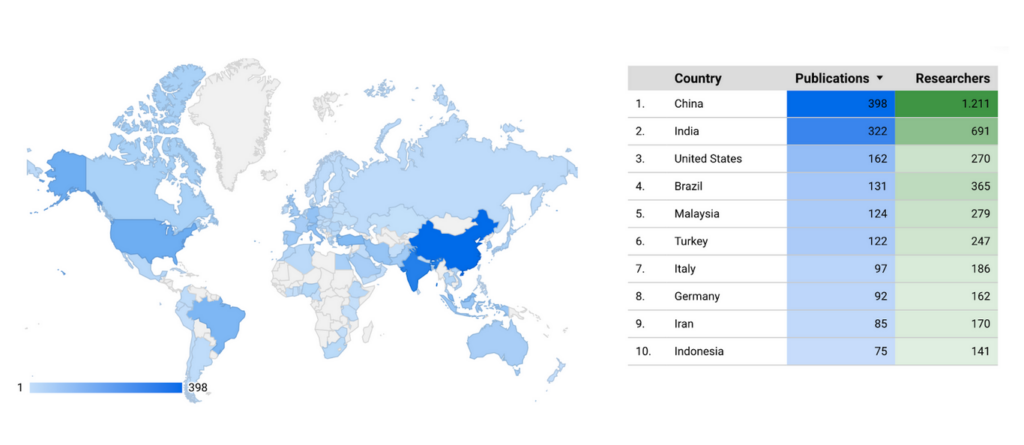
The detailed search resulted in 4,446 publications identified in Dimensions across a 10-year time period (see Fig. 3 below). An increased upward trend from 2017 to 2021 is evident, which is suggestive that the years following implementation of the UN SDGs in 2016, highlights the increased importance of research in this domain. Looking at the percentage differences (see Table 1) where the pre-SDG has been compared with post-SDG, time periods, the difference is clearly evident, with a threefold increase in published research after the implementation of the SDGs, again potentially indicative of this influence and the 2030 Agenda.


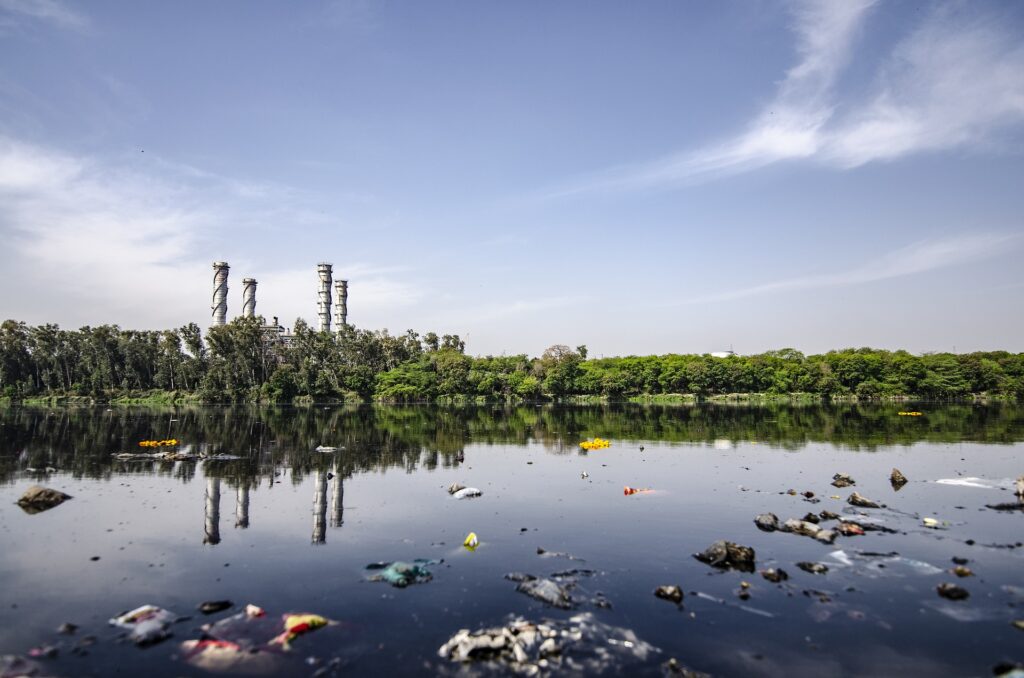
Sustainable Development Goals (SDGs), wastewater and textile manufacturing, in Dimensions
Academic institutions play a crucial role in ensuring the success of the SDGs, and scientific research is one of the most relevant dimensions for the achievement of the 2030 SDG Agenda.11 It addresses real-world problems, societal needs, and innovative technologies necessary to break new ground for sustainable development.
Taking the research outputs following the detailed search, we filtered for those publications that have been classified as relating to the UN Sustainable Development Goals (using the Dimensions SDG classification system – see Fig. 4 below).
In total, Dimensions generated 572 SDG associated outputs. Of this total, 272 were related to SDG6 ‘Clean Water and Sanitation’, revealing it as one of the main SDG drivers for sustainable development research. Within SDG6 there are eight outcome targets, the third of which -Target 6.3 – is especially relevant here. It demands that: “By 2030, improve water quality by reducing pollution, eliminating dumping and minimising release of hazardous chemicals and materials, halving the proportion of untreated wastewater and substantially increasing recycling and safe reuse globally”.
Looking at the FoR categories associated with the outputs we note that the 272 SDG6 outputs are predominantly associated with Engineering, Environmental Engineering, Chemical Engineering and Chemical Sciences. It is understood that realising SDG6 includes overcoming numerous challenges, one of which is water pollution from the release of hazardous materials by the textile industry, and the fields of research highlighted above fit well with publications that might address overcoming such challenges.
We also found that SDG7 (‘Affordable and Green Energy’ – 232 outputs) has a similar trajectory to that of SDG6 with a sharper increase of publications year on year from 2017, following the implementation of the UN SDGs (See Fig. 4). It is also an SDG where one might expect a considerable overlap with SDG6. To investigate this, we looked at the FoR categories associated with SDG7 and found that they were the same as for SDG6, predominantly in the fields of Engineering, Environmental Engineering, Chemical Sciences and Chemical Engineering.

Fields of Research (FoRs) categories, wastewater, water pollution and textile manufacturing
Table 2 below outlines the top six research producing countries as evidenced by the highest number of publications in the five dominant FoR categories – the research focus direction. What is apparent here is that China is the top research producing country with approximately 50% of its published research identified as being in the FoRs of Engineering and Chemical Sciences categories, whereas for India and Turkey it is in the FoRs Engineering and Environmental Engineering categories. For all of the six countries identified, Engineering is the top FoR category.12

Keyword co-occurrence analysis
A keyword co-occurrence analysis of all the keywords attached to the published research in the specified search was carried out using VOSviewer13 (See Fig, 6 below). The VOSviewer tool allows the evaluation of all keywords attached to the publications and assesses the strength of the links between them. It attaches a relevance score providing an indication of the strength of the links to the topic of the publication. The colours of the nodes refer to their average relevance amongst the links that have been counted (tenuous links are not counted as relevant) and the higher co-occurrence amongst items is represented by the size of the nodes.
Following an interrogation of the keyword co-occurrences involved in the network visualisation outlined below, their links to FoRs becomes evident:
- The blue and lime green clusters connect and centre around the dyeing process and chemicals involved in this, and are chiefly associated with the Chemical Sciences FoR category.
- The red cluster mainly overlaps with the purple cluster and relates to components of wastewater and treatment technologies and is associated with the Engineering FoR.
- The green cluster and the lime green cluster are also connected and relate to treatment efficiencies and conditions centred around dyeing, and associate with Engineering, Chemical Sciences and Physical Chemistry FoR categories.
These observations allow for a different perspective on the association amongst fields of research and we are able to see more comprehensive relationships revealing their multidisciplinary nature.
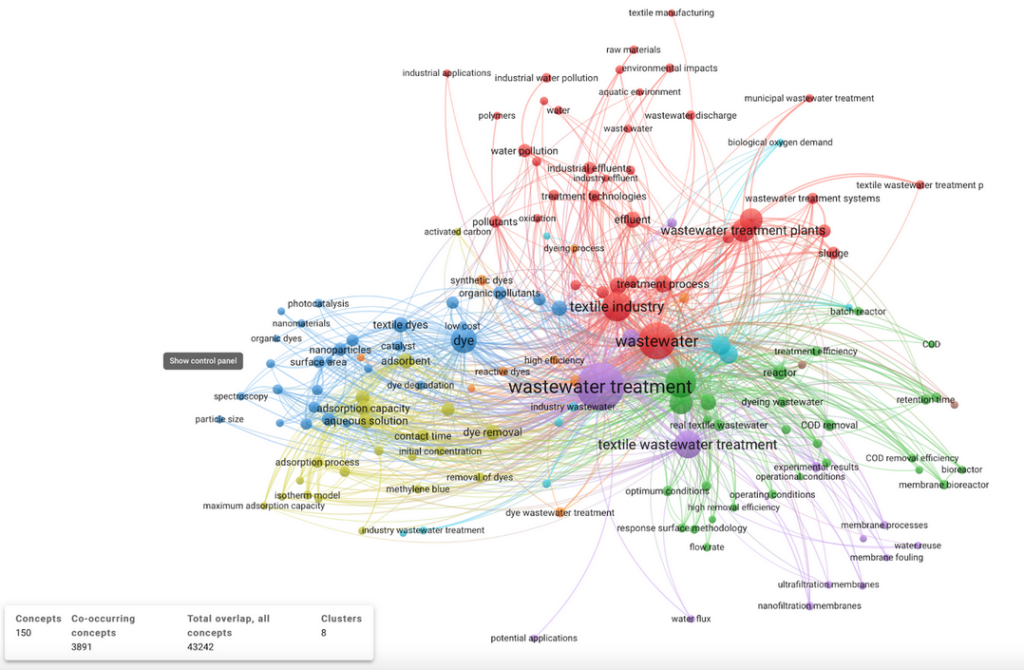
Conclusions
The main focus of this blog was to look at wastewater and water pollution in textile manufacturing and to explore the association between the scientific literature within two of Dimensions’ classification systems – SDGs and FoRs. The article has set out a descriptive analysis of features of the research on wastewater pollution in the textile industry.
We carried out an initial search using Dimensions to assess how much of the research literature could be associated with wastewater and water pollution. Having established that Dimensions yielded a substantial number of publications (256,967 outputs), we narrowed down the focus of the search by increasing the number of search terms to create a search string that focused more specifically on wastewater and water pollution within the textile industry. The rationale for this was that textile manufacturing has developed rapidly in recent years which has led to increasing concerns regarding textile wastewater pollution. This search yielded 4,475 publications. We were particularly interested in looking at how much textile manufacturing wastewater research underpinned the SDGs, in particular SDG6 Clean Water and Sanitation, as well as looking at timelines to ascertain any potential trends, such as those that might be evident pre- and post-SDG implementation. The results indicated that the number of research publications did sharply increase post-SDG implementation and that SDG6, as well as SDG7, Affordable and Green Energy, were the main SDG drivers of this research. Given the overlapping nature of these two SDGs, it makes sense that they both would feature highly.
A further layer of interest was our investigation of the Fields of Research classifications underpinning the outputs from the Dimensions search, which revealed, not unexpectedly, that wastewater pollution in textile manufacturing has been studied in a number of different FoR categories, with publications in Engineering, Environmental Engineering and Chemical Sciences being the most published areas, followed by Chemical Sciences. In an attempt to understand potential differences in research focus in different countries we looked at the top six research producing countries and FoR categories, which revealed that China came top with 608 publications, followed by India with 533 and Turkey with 279 publications.
Finally, using VOSviewer to create a network co-occurrence analysis, we confirmed our findings highlighting those areas of research focusing on the environment, on the chemistry involved, on water, and its treatment in the urban environment, as well as textile dyes and their removal.
For more information about how Dimensions can provide detailed insights into the research ecosystem, please visit the Dimensions website.
About the Authors
Dr Juergen Wastl, Director of Academic Relations and Consultancy |Digital Science
Dr Wastl previously headed up the Research Information team at the University of Cambridge’s Research Strategy Office.
Dr Briony Fane, Research Analyst |Digital Science
Dr Fane has a higher education background, having gained a PhD from City, University of London, and has worked as both a researcher and a research manager.
1 https://www.unwater.org/water-facts/quality-and-wastewater/
2 https://www.nature.com/articles/s41545-020-0069-3
4 https://www.frontiersin.org/articles/10.3389/feart.2021.744224/full
5 https://www.sciencedirect.com/science/article/abs/pii/S0043135421008502?via%3Dihub
6 https://dx.doi.org/10.3390/su12197841
7 https://link.springer.com/chapter/10.1007%2F978-3-319-32845-4_9
8 https://www.iea.org/reports/an-energy-sector-roadmap-to-carbon-neutrality-in-china
9 https://sdgs.un.org/goals/goal6
10 Detailed search string
((“textile production” AND “water pollution”) OR (“garment dyes” AND pollution) OR (“textile manufacturing” AND wastewater) OR (“textile processes” AND pollution) OR (“wastewater discharge” AND “textile industry”) OR (“water eutrophication” AND textiles) OR (“Water Ten Plan”) OR (“untreated wastewater” AND “textile production”) OR (“wastewater treatment” AND textiles) OR (“garment dye” AND “water pollution”) OR (“garment dyes” AND “water pollution”) OR (“textile manufacturing” AND water pollution) OR (“textile pollutants AND wastewater”) OR (“wastewater chemical pollutants” AND “textile production”) OR (“wastewater chemical pollutants” AND “textile manufacturing”) OR (“water pollutant discharge” AND “textile production”) OR (“textiles wastewater”) OR (“industrial water pollution”))
11 https://www.frontiersin.org/articles/10.3389/frsus.2021.620743/full
12 It is important to caveat here that given the narrow focus, numbers are small and relative and differences are not substantial.
13 van Eck, N. J.; Waltman, L. (2010) VOSViewer: Visualizing Scientific Landscapes [Software]. Available from https://www.vosviewer.com

